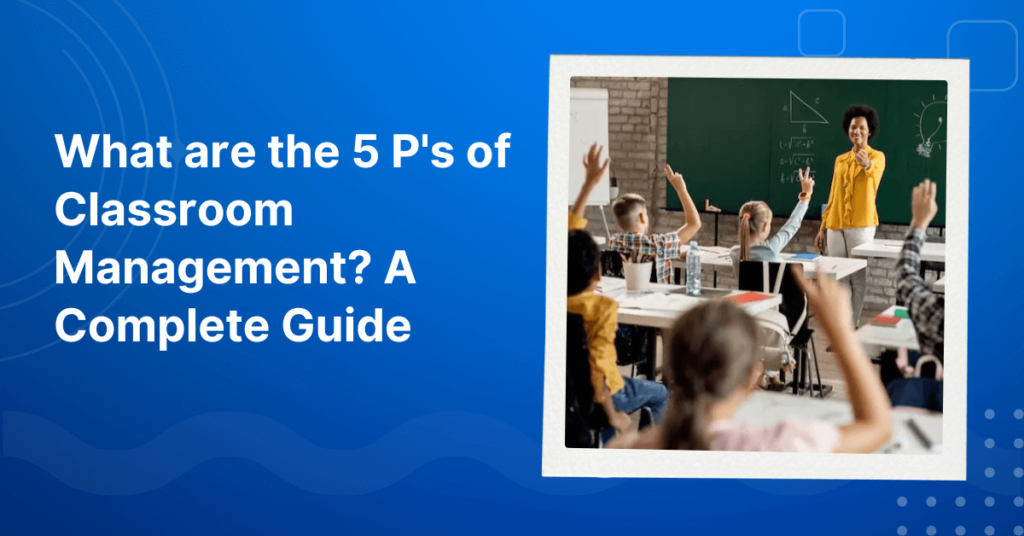The 5 P’s of classroom management — Prompt, Prepared, Productive, Polite, and Positive—form a powerful framework that transforms chaotic classrooms into effective learning spaces. These fundamental principles help teachers create structured, engaging environments where students excel academically and develop positive behaviors. Let’s explore how each ‘P’ contributes to successful classroom management strategies and practical implementation techniques.

How Do the 5 P’s Improve Classroom Management
Why is Being Prompt Essential for Classroom Success?
Being prompt means being on time, but it’s more than just arriving at the beginning of class. It also involves starting lessons promptly and responding quickly when students need assistance. Teachers who show up on time set a strong example for their students. If a teacher is always late, students might follow that lead, arriving late themselves and disrupting the class.
In practice, a teacher could set a rule where students are encouraged to be in their seats with their materials ready when the bell rings. For instance, a middle school math teacher uses a five-minute countdown on the board to encourage students to settle down quickly. This prompt start not only maximizes learning time but also sets a serious, focused tone for the lesson.
Promptness also applies to responding to students. If a student consistently arrives late, it’s helpful to address the issue early on. Instead of just saying, “You’re late again,” explain why being on time matters—whether it’s for maintaining a respectful learning environment or improving their grades.
How Does Being Prepared Transform Teaching Effectiveness?
Being prepared is about both teachers and students coming to class ready to learn. For students, this means bringing all necessary materials, such as textbooks, notebooks, and pens. For teachers, it means having lessons planned and materials ready to go.
For example, a science teacher always has his lab setup ready before students enter the room. This prevents delays during the lesson and ensures that everything runs smoothly. He also encourages students to check the classroom website before school to know what materials they need for the day.
Preparedness goes a long way in reducing chaos. When students are not prepared, it disrupts their focus and affects others. A classroom rule might be, “Always come to class with your books, homework, and a positive attitude.” This reinforces the idea that being ready is essential for success, both in school and in life.
Discover Related Guides: What are the 4 C’s of classroom management?

What Makes a Productive Classroom Environment
Being productive is about making the most of class time. This means minimizing distractions and staying focused on the tasks at hand. Teachers can create a productive environment by establishing clear expectations from the start. Let students know what they will be learning that day and outline any activities they’ll be doing.
For example, an English teacher sets a productivity rule: “No phones or other distractions during work time.” She also clearly states the lesson goals at the beginning of class, like “Today, we’re focusing on writing strong thesis statements.” This ensures students know what they are expected to accomplish during the period.
Productivity isn’t just about rules—teachers can make learning more engaging by incorporating activities that require active participation, like group discussions or interactive games. Ms. Davis rewards students who stay focused with a participation grade, making sure they know their efforts matter.
Why Do Polite Interactions Matter in Class Management?
Politeness in the classroom means treating others with respect, whether it’s the teacher, classmates, or even the learning space itself. Being polite helps maintain a positive and supportive classroom environment where students feel safe and valued.
For instance, a history teacher emphasizes politeness by having a classroom rule that says, “Listen when others are speaking.” He models this behavior by listening attentively when students share their thoughts during discussions. He also has a “Polite Points” system where students can earn recognition for helping others or being respectful in class.
Politeness extends to how students treat their classroom as well. Picking up after themselves or respecting the materials provided are simple ways to encourage a culture of respect. When everyone is polite, it makes the classroom a more pleasant place to learn.
How Does a Positive Approach Impact Student Behavior
Having a positive attitude is key for both teachers and students. A positive classroom encourages students to take risks, make mistakes, and learn from them without fear of judgment. Teachers who focus on the positives help build students’ confidence and motivation.
A middle school art teacher, fosters positivity by celebrating even small successes. If a student tries a new drawing technique and doesn’t quite get it right, she praises the effort and provides constructive feedback. Her classroom rule is simple: “Stay positive and keep trying, even when it’s tough.”
Positivity can also be incorporated into classroom routines. For example, starting the day with a quick “win of the day” where students share something good that happened, helps set a positive tone for the class. Encouraging students to believe in themselves and each other builds a strong, supportive classroom community.

How to Implement the 5 P’s in Your Classroom
The 5 P’s work together to create a balanced classroom environment. Promptness ensures that time is used effectively, preparedness reduces disruptions, productivity encourages focus, politeness fosters respect, and positivity builds confidence. When these principles are in place, classroom management becomes smoother, and students are more likely to succeed academically and socially.
What Does Successful 5 P’s Implementation Look Like? Real Examples
Let’s look at how the 5 P’s can play out in a real-life situation. Imagine a typical Monday morning in Mr. Roberts’ classroom. As the bell rings, students immediately take their seats (Prompt) and pull out their notebooks and pencils (Prepared). Mr. Roberts begins the lesson on fractions, making sure to explain the day’s goals clearly (Productive). During group work, students are polite to one another, taking turns speaking and helping each other solve problems (Polite). Even when a group struggles to understand a tough problem, Mr. Roberts encourages them to keep trying and stay positive (Positive).
In this scenario, the 5 P’s work together to create a calm, focused, and respectful classroom where students can learn without distractions.

In conclusion, understanding “What are the 5 P’s of classroom management?” is key to creating a positive and productive learning environment. By applying these principles, teachers can effectively manage their classrooms and support student success.







I have empowered by 5 Ps in a classroom
Classroom management is very crucial at all levels so thanks so much for the eye opener I have gained a lot
Dear Linda Buyisiwe Sidaki, we are very happy to have been of assistance to you in your teaching process.